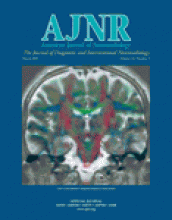Abstract
BACKGROUND AND PURPOSE: Various MR techniques have been used to assess CSF flow and to image the subarachnoid spaces and ventricles. Anecdotal reports describe the use of intrathecal and intraventricular gadolinium-based contrast agents in humans and animals. We sought to determine the clinical usefulness of gadolinium-enhanced MR ventriculography for assessing CSF flow in patients with various neurologic conditions.
METHODS: Five patients (three female and two male patients aged 6 months to 65 years) were included in the study. After performing sagittal, coronal, and axial T1-weighted MR imaging of the brain, 0.02–0.04 mmol of gadodiamide was injected into the lateral ventricle. Sagittal, coronal, and axial T1-weighted imaging was repeated soon after the injection. We were specifically looking for the site of obstruction to CSF flow in those patients with hydrocephalus, communication between cysts and ventricles, elucidation of suspicious intraventricular lesions, and patency of third ventriculostomies.
RESULTS: MR ventriculography showed good delineation of the ventricular system in all patients. In one patient with carcinomatosis and hydrocephalus, a block to contrast material flow was detected at the right foramen of Luschka. In another patient with hydrocephalus, partial block to the flow of contrast material was demonstrated at the right foramen of Monro. In a patient with hydrocephalus and a posterior fossa cyst, flow of contrast material was blocked between the third ventricle and the cyst, with a thin streak of contrast material in the aqueduct. As an assessment of the patency of a third ventriculostomy, MR ventriculography showed flow of contrast material into the suprasellar cisterns from the third ventricle in one patient and absence of flow in another.
CONCLUSION: MR ventriculography is a safe technique for assessing CSF flow, with application in determining the site of obstruction in hydrocephalus, in assessing communication between cysts and the ventricle, and in determining the functioning status of endoscopic third ventriculostomies.
- Copyright © American Society of Neuroradiology












